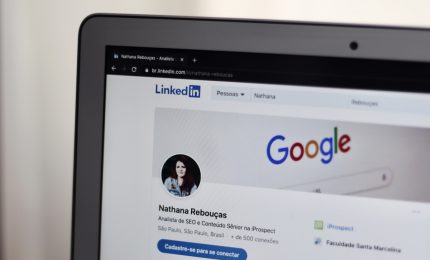Branding in the age of social media is as critical as it is difficult. Currently, there are about 3.2 billion active users worldwide, according to the Digital in 2018 report by Hootsuite and We Are Social. For small business owners, you can’t afford to not have a social presence, as 70 percent of all businesses use social media, according to a Clutch survey.
However, there’s a slight catch-22 in our DIY-friendly/digital landscape. While social media makes it easier than ever to build an online brand presence, the crowded space also means that it’s challenging to make your brand stand out. You need to be strategic so social media isn’t a waste of your valuable time and resources.
Whether you’re a new business, or simply reassessing your current social strategy, use this guide to ensure your business is poised for success when branding in the age of social media. Make social media work for your brand (and not the other way around).
Become a Member: Marketing from the Gut Instagram membership coaching program
Align Your Strategy With Your Business Goals
Nearly half of social marketers say their greatest challenge is developing strategy that supports overall business goals, according to recent data. When developing your social media strategy, you need to connect it with your overall mission (branding) and business goals (to drive sales).
The social experts at Hootsuite recommend that you keep this in mind when setting social media goals. “Sure, vanity metrics are fun to track. But can you tie these simple measures directly to business goals? Will increasing your likes lead to real business value? (In some cases, it very well might. But put in the time to really think about this upfront).”
To start, develop quantifiable metrics that align social media performance with your business objectives. For example, “earn 10% of leads from Facebook” or “increasing organic traffic from Twitter by 15%.”
If this sounds over your head, check out our guide, social media analytics made simple.
Don’t forget to consider whether social media is even necessary for your business. The cosmetics company Lush famously swore off all social media. In a final Instagram post, they explained:
“Increasingly, social media is making it harder and harder for us to talk to each other directly. We are tired of fighting with algorithms, and we do not want to pay to appear in your newsfeed. So we’ve decided it’s time to bid farewell to some of our social channels and open up the conversation between you and us instead.”
– Lush Cosmetics
Still lost? Try using these five (non-traditional) pillars of social media strategy to set goals and align your social media branding and business objectives.
Focus on the Right Social Media Platforms
Before you spend any time or effort, you need to find the platform that caters best to your brand, which in turn, allows you to reach your target audience. For example, despite having 250 million monthly average users, Pinterest would be too off-brand for a car mechanic business.
However, there are many social media sites to choose from, with more rising in the ranks of popularity each day (refer to Social Media explorer’s list of up-and-coming networks), which can make it hard to choose the right ones. When you choose the most on-brand platforms, as opposed to making ad-hoc decisions about where to be active on social media, you avoid spreading yourself thin. Instead of a mediocre presence on several sites, you have a quality presence on just a few, or even just one.
Remember, with social media branding, focus on quality over quantity.
Here are the most-used and highest trafficked platforms for businesses, with some basic demographics to guide your plan. Your goal here is to match up where your target audience lives, then focus on the 2 to 3 platforms that best align with your brand.

Other Factors to Consider for Each Platform
- Facebook can feel like a pay-to-play platform with 22 percent of all business pages using paid ads, according to the same Digital in 2018 report. You do need Facebook to authenticate an Instagram profile, but consider how much time you want or need to spend marketing here. A good indicator can be looking at your competitors to see how active they are, and more importantly, how active their audience is. Are they getting likes, comments and shares? Or simply posting with no response at all.
- Instagram is a visual-heavy platform with emphasis placed on curated images and videos. The only copy or text is in captions and in the limited bio space, which includes just one link. If your brand doesn’t have original visual content to share (images, videos, high-quality branded graphics), or doesn’t lend itself well to this format, Instagram might not be the best option for you. More often, Instagram works better for B2C businesses than B2B.
- Twitter is a space that shows returns if you put in the effort. To see valuable growth you need to spend time thoughtfully posting, commenting, and engaging with others. If you don’t have that kind of time on your hands, it will take longer to see growth, if you do at all. Note that Twitter is a powerful tool for customer service—more on that below.
- LinkedIn is the professional social network. It’s the ideal space for B2B organizations to share industry-relevant content and thought leadership articles. It’s also a powerful recruiting and networking tool, so even B2C businesses might consider spending time here if actively hiring.
- Pinterest thrives on creative content, (think: crafting, DIY design, weddings). Before committing to this platform, dive into some competitor research to ensure it makes sense for your vertical and space.
Download the free competitor research template and checklist and don’t miss the full competitor analysis guide to get started.
Develop a Voice and Tone That Stands Out
Your overall messaging is integral to your brand’s presence. Social media is a crowded space, so your voice needs to be spot on to attract your audience and give them something to connect to. While captions might seem like short-form copy—280 characters on Twitter or a comment on Instagram—it’s the outward perception of how you represent your brand, via voice and tone.
CoSchedule defines brand voice and tone as:
- Voice describes your company’s personality, it’s consistent and unchanging.
- Tone is the emotional inflection applied to your voice. It adjusts to what’s suitable for a particular piece or message.
Refer to their guide for further direction on establishing your own brand voice.
In this Social Personality Index Report, Sprout Social explains why messaging can be a fine line to walk for some brands: 7 in 10 consumers find slang-usage irritating and 88 percent of consumers feel annoyed if a brand mocks their fans. SproutSocial calls this the “cost of being cool.”
When in doubt, opt for an authentic tone and value-driven messaging. According to that same report, the top three behaviors consumers want from brands are honesty, friendliness, and helpfulness.
A recent survey further supported this theory and found that 86 percent of consumers say authenticity is important when deciding which brands to support. You likely won’t go viral for being gimmicky or sarcastic (leave the latter to the Wendy’s of the world), but as a small business, you can forge a connection with your audience. Give them what they crave: authentic messaging.
Create Visuals Consistent With Your Brand
Social media is a visual world. You can’t simply post text or links and expect a user to stop scrolling on their feed. Images get 2.3 times more engagement than text alone, according to Buzzsumo. Images with people do better than images without, based on new research and a scientific study even found that aesthetic and quality of images significantly affects likes. Bottom line—visuals matter.
If you want your brand to visually stand out on social—consistency is key. Create unique graphics that are in line with your overall branding. If you don’t have any assets yet, I.E. a logo, branding guide, colors, font, etc., consider using an AI tool like Zyro for creating your logo or outsourcing to get started.
Freelance graphic designers are readily available and can help you develop a branding guide. To estimate potential costs, use Upwork’s guide to working with a graphic designer.
Once you have a brand guide developed, use free tools to design simple and unique branded visuals that complement and further your brand on social media. Check out the graphic that Jessica Thiefels shared from Hubspot—simple and clean:
Even if you’re not graphically-inclined, free tools like Canva make it simple to create quick and easy visuals, with thousands of plug-and-play templates and stock images.
For a deeper dive, read Canva’s guide to building a visual brand identity, complete with links to relevant templates!
Understand the Algorithms to Drive More Brand Impressions
One frustrating aspect of social media management is the platform-specific, ever-changing algorithm. Facebook’s changes alone are extensive and regular. Check out this timeline from Wallaroo Media, which includes every major algorithm change we’ve seen.
Algorithm changes are meant to protect the social user and audience while keeping platforms from becoming ad-centric. However, it can feel like you need to understand how to play a game in order to be seen—and you kind of do.
Be proactive and learn about how the algorithms work so that you can work to drive more organic brand impressions. Bookmark SocialMediaToday’s guide to social media algorithms; it explains a little about each, with tips on how to work them to your advantage.
To take it one step further and stay up-to-date on the latest news, follow industry experts on your social feeds, so you can see when trends or algorithms change. Here are our favorites:
- Sprout Social
- Hootsuite
- Buffer
- Social Media Examiner
- Social Media Today
Don’t forget to use the resources available to you to get around algorithm challenges. For example, Hopper’s Best Time to Post on Instagram tool makes it easy to find the best times to reach your audience. Most social media platforms and scheduling tools have similar insights you can use to make sure your brand is reaching your audience when they’re most active.
Look to Big Brands for Inspiration
To end on a note of inspiration, take some ideas from the companies that have stand-out brands on social media. Notice their unique tactics and the different elements they focus on to make their social posts stand out from the crowd.
Southwest Airlines
Southwest’s brand is known for running on heart. Look at their replies on Twitter to confirm that they give some serious love to angry tweeting travelers. Updated by the minute, their team responds to grumpy people in airports with kindness and patience. They also personalize each tweet with a customer service rep’s name to humanize the process.
Key takeaway: Respond to customers queries or mentions on social platforms. Consider using a first name to personalize the response.
Airbnb
Airbnb’s Instagram is highly curated and will give anyone travel FOMO. The best part is all the images come from rentable-Airbnbs and is mostly user-generated content (UGC). They even used their social media to launch the highly-successfully new initiative, Airbnb Experiences, with an engaging, video-based, campaign on Instagram. (Read more about it here). To engage even further with their customers, they use Instagram stories to share guest spotlights.
Key takeaway: If you have UGC, use it to your advantage. Social media is the perfect place to highlight and engage your happy customers and followers, while simultaneously increasing your brand awareness. Learn how you can leverage UGC as a small business.
Innocent Drinks
Beyond a silly and slightly irreverent brand tone, UK-based Innocent Drinks stays current on social, cultural, and topical news on Twitter. They especially focus on sustainability, a theme that aligns with their brand’s mission. Check out their replies and see that they interact with any mention of their brand in a fun and silly manner. They also participate in conversations about their goals as a business.
Key takeaway: You can cover a lot of bases with your messaging, like respectfully educating followers about your product, playfully recognizing positive UGC, and promoting themes relevant to your brand’s mission.
Shopify
This e-commerce giant is hugely successful with Facebook. You’ll notice when you click “message” that they usually respond within an hour, making them a readily available brand—something consumers want. Shopify also uses the platform in diverse ways, sharing:
- Industry updates, via articles, reports, and infographics
- Unique case studies on successful Shopify customers, both in the form of videos and articles
- How-to video guides and tutorials
Key takeaway: While you might not have the 3.4 million followers that Shopify does, you can use their Facebook posts as inspiration for using the robust features of the platform. If you have the time and expertise, you can build out your page that’s both brand-building and an engaging resource for your audience.
Made.com
Online furniture designers, Made.com, are the quintessential Pinterest brand. With 63 thousand followers and 6.4 million monthly views, their account uses the platform perfectly. Which makes sense, because they’re a design and aesthetic-focused company. Their boards cover full home tours, room-specific interior design, the latest trends, guides, and more.
Key takeaway: Focus your time on the appropriate platform. Made knows that their audience is present on Pinterest and the network lends itself well to the content they have to promote.
Branding in the Age of Social Media
It can feel overwhelming, but you can stand out with branding in the age of social media. Use these examples, ideas, data points and resources to use social media to your advantage and build a brand customers remember and love.




